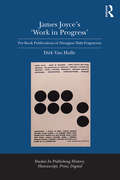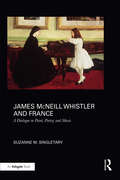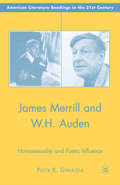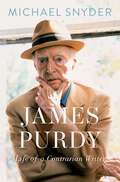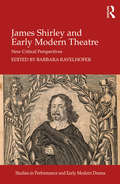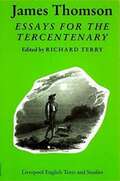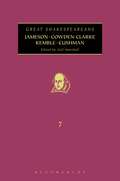- Table View
- List View
James Joyce's 'Work in Progress': Pre-Book Publications of Finnegans Wake Fragments (Studies in Publishing History: Manuscript, Print, Digital)
by Dirk Van HulleThe text of Finnegans Wake is not as monolithic as it might seem. It grew out of a set of short vignettes, sections and fragments. Several of these sections, which James Joyce confidently claimed would "fuse of themselves", are still recognizable in the text of Finnegans Wake. And while they are undeniably integrated very skillfully, they also function separately. In this publication history, Dirk Van Hulle examines the interaction between the private composition process and the public life of Joyce's 'Work in Progress', from the creation of the separate sections through their publication in periodicals and as separately published sections. Van Hulle highlights the beautifully crafted editions published by fine arts presses and Joyce's encouragement of his daughter's creative talents, even as his own creative process was slowing down in the 1930s. All of these pre-book publications were "alive" in both bibliographic and textual terms, as Joyce continually changed the texts in order to prepare the book publication of Finnegans Wake. Van Hulle's book offers a fresh perspective on these texts, showing that they are not just preparatory versions of Finnegans Wake but a 'Work in Progress' in their own right.
James Joyce's World (Routledge Revivals)
by Patricia HutchinsFirst published in 1957, this book explores what remained of Joyce’s background, not only in Ireland but in those cities abroad where his books were written. With the co-operation of those who knew the author, including his brother, much new material was brought together to shed new light on Joyce’s life, character and methods of writing. The author traces Joyce, and his writings, from his beginnings in Ireland, through Zürich, London and Paris, to his difficult final year at Vichy in 1940. Previously unpublished letters illustrate his relationships with important figures of the period like Ezra Pound, T.S. Eliot and H.G. Wells. This title will be of interest to student of literature.
James Joyce's World (Routledge Revivals)
by Patricia HutchinsFirst published in 1957, this book explores what remained of Joyce’s background, not only in Ireland but in those cities abroad where his books were written. With the co-operation of those who knew the author, including his brother, much new material was brought together to shed new light on Joyce’s life, character and methods of writing. The author traces Joyce, and his writings, from his beginnings in Ireland, through Zürich, London and Paris, to his difficult final year at Vichy in 1940. Previously unpublished letters illustrate his relationships with important figures of the period like Ezra Pound, T.S. Eliot and H.G. Wells. This title will be of interest to student of literature.
James Malcolm Rymer, Penny Fiction, and the Family (Routledge Studies in Nineteenth Century Literature)
by Rebecca NesvetJames Malcolm Rymer, Penny Fiction, and the Family is the first monograph focusing on Sweeney Todd and Varney the Vampyre’s creator James Malcolm Rymer (1814–1884). It argues that Rymer wrote his so-called ‘penny bloods’ and ‘dreadfuls’ for and about British urban working families. In the 1840s, the notion of the family acquired unprecedented prominence and radical potential. Raised in an artisanal artistic-literary family, Rymer wrote for and edited family magazines early in that genre’s history, deployed Chartist domesticity to liberal ends, and collaborated with cheap publisher Edward Lloyd to define and popularise the domestic romance genre. In 1850s–1860s penny serials published by George W.M. Reynolds, John Dicks, and Lloyd, Rymer showed how families might sustain Empire and advocated for patriarchal family dynamics in response to literary and political change. During the fin-de-siècle, Rymer’s penny fiction was demonised as hyper-masculine ‘bloods’ and ‘dreadfuls’, a reputation it retains today. Reading Victorian penny fiction’s most indicative author’s works as a corpus and with attention to their original textual, cultural, and political contexts reveals it as the family-oriented phenomenon it in fact was.
James Malcolm Rymer, Penny Fiction, and the Family (Routledge Studies in Nineteenth Century Literature)
by Rebecca NesvetJames Malcolm Rymer, Penny Fiction, and the Family is the first monograph focusing on Sweeney Todd and Varney the Vampyre’s creator James Malcolm Rymer (1814–1884). It argues that Rymer wrote his so-called ‘penny bloods’ and ‘dreadfuls’ for and about British urban working families. In the 1840s, the notion of the family acquired unprecedented prominence and radical potential. Raised in an artisanal artistic-literary family, Rymer wrote for and edited family magazines early in that genre’s history, deployed Chartist domesticity to liberal ends, and collaborated with cheap publisher Edward Lloyd to define and popularise the domestic romance genre. In 1850s–1860s penny serials published by George W.M. Reynolds, John Dicks, and Lloyd, Rymer showed how families might sustain Empire and advocated for patriarchal family dynamics in response to literary and political change. During the fin-de-siècle, Rymer’s penny fiction was demonised as hyper-masculine ‘bloods’ and ‘dreadfuls’, a reputation it retains today. Reading Victorian penny fiction’s most indicative author’s works as a corpus and with attention to their original textual, cultural, and political contexts reveals it as the family-oriented phenomenon it in fact was.
James March's Exploration and Exploitation in Organisational Learning (The Macat Library)
by Padraig BeltonExploration and Exploitation is a key text for scholars and business practitioners interested in promoting economic well-being and sustainable growth. March’s work promotes the preservation of companies’ competitiveness and sustainability in the fluctuating market environment by maintaining a balance between exploration and exploitation processes. He explicates that this balance depends on the interchange between the adaptive capability of the company, predictability and consistency, competition, anticipations, level of risk, learning, socialization dynamics within the organization, and the overall environmental turbulence. These intricacies make March’s text invaluable.
James March's Exploration and Exploitation in Organisational Learning (The Macat Library)
by Padraig BeltonExploration and Exploitation is a key text for scholars and business practitioners interested in promoting economic well-being and sustainable growth. March’s work promotes the preservation of companies’ competitiveness and sustainability in the fluctuating market environment by maintaining a balance between exploration and exploitation processes. He explicates that this balance depends on the interchange between the adaptive capability of the company, predictability and consistency, competition, anticipations, level of risk, learning, socialization dynamics within the organization, and the overall environmental turbulence. These intricacies make March’s text invaluable.
James McNeill Whistler and France: A Dialogue in Paint, Poetry, and Music
by Suzanne SingletaryJames McNeill Whistler and France: A Dialogue in Paint, Poetry, and Music is the first full-length and in-depth study to position this painter within the overall trajectory of French modernism during the second half of the nineteenth century and to view the artist as integral to the aesthetic projects of its most original contributors. Suzanne M. Singletary maintains that Whistler was in a unique situation as an insider within the emerging French avant-garde, thereby in an enviable position to both absorb and transform the innovations of others – and that until now, his widespread influence as a catalyst among his colleagues has been neither investigated nor appreciated. Singletary contends that Whistler’s importance rivals that of Manet, whose multi-layered (and often unexpected) interconnections with Whistler are the focus of one chapter. In addition, Whistler’s pivotal role in linking the legacies of Baudelaire, Delacroix, Gautier, Wagner, and other mid-century innovators to the later French Symbolists has previously been largely ignored. Courbet, Degas, Monet, and Seurat complete the roster of French artists whose dialogue with Whistler is highlighted.
James McNeill Whistler and France: A Dialogue in Paint, Poetry, and Music
by Suzanne SingletaryJames McNeill Whistler and France: A Dialogue in Paint, Poetry, and Music is the first full-length and in-depth study to position this painter within the overall trajectory of French modernism during the second half of the nineteenth century and to view the artist as integral to the aesthetic projects of its most original contributors. Suzanne M. Singletary maintains that Whistler was in a unique situation as an insider within the emerging French avant-garde, thereby in an enviable position to both absorb and transform the innovations of others – and that until now, his widespread influence as a catalyst among his colleagues has been neither investigated nor appreciated. Singletary contends that Whistler’s importance rivals that of Manet, whose multi-layered (and often unexpected) interconnections with Whistler are the focus of one chapter. In addition, Whistler’s pivotal role in linking the legacies of Baudelaire, Delacroix, Gautier, Wagner, and other mid-century innovators to the later French Symbolists has previously been largely ignored. Courbet, Degas, Monet, and Seurat complete the roster of French artists whose dialogue with Whistler is highlighted.
James Merrill and W.H. Auden: Homosexuality and Poetic Influence (American Literature Readings in the 21st Century)
by P. GwiazdaJames Merrill and W.H. Auden offers a substantial analysis of the literary and personal relationship between two major twentieth-century poets. As Gwiazda argues, Auden's prominence in the post-World War II American poetry scene as a homosexual poet and critic makes his impact on Merrill particularly noteworthy. Merrill's imaginary recreation of Auden in his occult verse trilogy The Changing Light at Sandover (1982) offers a powerful statement about the dynamics of poetic influence between gay male poets. Combining archival research, textual analysis, and aspects of queer theory, James Merrill and W.H. Auden examines Sandover's implications to the contentious issues of homosexual identity and self-representation.
James Orr, Poet and Irish Radical (Poetry and Song in the Age of Revolution)
by Carol BaraniukJames Orr was the foremost of the Ulster Weaver poets and has been favourably compared to his near contemporary Robert Burns. Baraniuk looks at Orr's life and work, examining the changing social, political and theological context of his writing and reassessing his contribution to radical literature and culture during the Romantic era.
James Orr, Poet and Irish Radical (Poetry and Song in the Age of Revolution #5)
by Carol BaraniukJames Orr was the foremost of the Ulster Weaver poets and has been favourably compared to his near contemporary Robert Burns. Baraniuk looks at Orr's life and work, examining the changing social, political and theological context of his writing and reassessing his contribution to radical literature and culture during the Romantic era.
James Patterson: A Critical Companion (Critical Companions to Popular Contemporary Writers)
by Joan KotkerSince the publication and cinematic success of 1992's Along Came a Spider, James Patterson seems to have taken up permanent residence on the bestseller lists. In the ensuing decade, his hit detective novels, with memorable nursery rhyme titles like Cat and Mouse, (1997) and Pop! Goes the Weasel (1999), came in rapid-fire succession and generated similar popularity and praise. His Alex Cross series created one of the most recognizable detectives in literature, and one of the first urban African American detectives to appeal, on such a grand scale, to audiences of all demographics. With full literary analyses of ten of his most popular works of fiction, this critical companion offers readers a chance to more fully explore Patterson's writings. Beginning with his 1976 bestseller The Thomas Berryman Number and moving chronologically to 2002's 2nd Chance, each chapter examines elements of plot, character development, theme, and critical perspectives.A full chapter offers a delving biographical study of Patterson, including a brief timeline, that traces his early literary and personal interests and later professional achievements. Another chapter discusses the genres of detective and mystery writing, and situates Patterson 's contributions within this framework. Patterson's sociological writings are also considered. Whether for personal pursuits or school assignments, this volume provides ample insight and extensive bibliographic information on Patterson's work, including critical sources and reviews.
James Purdy: Life of a Contrarian Writer
by Michael SnyderA definitive biography of a twentieth century gay author whose work has recently been rediscovered and enjoys a cult following. One of the most iconoclastic twentieth-century American novelists, James Purdy penned original and sometimes shocking works about those on the margins of American society, exploring small towns, urban life, failure, alienation, sexuality, and familial relations. In his own life, Purdy was a compelling if eccentric figure, declared an "authentic American genius" by Gore Vidal. James Purdy: Life of a Contrarian Writer is the first full-length biography of the gay American novelist, story writer, playwright, and poet. Michael Snyder has spent over a decade plumbing the mysteries of Purdy's career and personal life, including interviews with those who knew him. From his roots in northwestern Ohio, Purdy moved to the world of Bohemian artists and jazz musicians in Chicago in the late 1930s and 1940s, travelled in Spain, studied in Mexico, enlisted in the Army Air Corps, worked for the National Security Agency, and taught in Cuba and at a Wisconsin college for nearly a decade. All the while, he aspired to become a writer, but struggled to publish. Only when friends financed the private printing of his work did he find a champion in poet Dame Edith Sitwell, who helped get him published in England, which led to publication in the United States. After moving to New York in 1957, he spent nearly fifty years writing in Brooklyn Heights. Although Purdy's critical reputation peaked in the 1960s and he never enjoyed a bestseller, his often queer and edgy content found a diverse following that included Tennessee Williams, Langston Hughes, William Carlos Williams, Dorothy Parker, Edward Albee, Jonathan Franzen, John Waters, and many LGBTQ readers. Difficult and often contrarian, Purdy sometimes hampered his own career as he sought recognition from a conservative, cliquey New York publishing world. Conveying the potency and influence of Purdy's fierce artistic integrity, vision, and self-definition as a truth-teller, this groundbreaking literary biography recovers the life of a highly talented writer with a persistent cult following.
James Purdy: Life of a Contrarian Writer
by Michael SnyderA New Yorker Best Book of 2022 A definitive biography of a twentieth century gay author whose work has recently been rediscovered and enjoys a cult following. One of the most iconoclastic twentieth-century American novelists, James Purdy penned original and sometimes shocking works about those on the margins of American society, exploring small towns, urban life, failure, alienation, sexuality, and familial relations. In his own life, Purdy was a compelling if eccentric figure, declared an "authentic American genius" by Gore Vidal. James Purdy: Life of a Contrarian Writer is the first full-length biography of the gay American novelist, story writer, playwright, and poet. Michael Snyder has spent over a decade plumbing the mysteries of Purdy's career and personal life, including interviews with those who knew him. From his roots in northwestern Ohio, Purdy moved to the world of Bohemian artists and jazz musicians in Chicago in the late 1930s and 1940s, travelled in Spain, studied in Mexico, enlisted in the Army Air Corps, worked for the Federal Security Agency, and taught in Cuba and at a Wisconsin college for nearly a decade. All the while, he aspired to become a writer, but struggled to publish. Only when friends financed the private printing of his work did he find a champion in poet Dame Edith Sitwell, who helped get him published in England, which led to publication in the United States. After moving to New York in 1957, he spent nearly fifty years writing in Brooklyn Heights. Although Purdy's critical reputation peaked in the 1960s and he never enjoyed a bestseller, his often queer and edgy content found a diverse following that included Tennessee Williams, Langston Hughes, William Carlos Williams, Dorothy Parker, Edward Albee, Jonathan Franzen, John Waters, and many LGBTQ readers. Difficult and often contrarian, Purdy sometimes hampered his own career as he sought recognition from a conservative, cliquey New York publishing world. Conveying the potency and influence of Purdy's fierce artistic integrity, vision, and self-definition as a truth-teller, this groundbreaking literary biography recovers the life of a highly talented writer with a persistent cult following.
James Shirley and Early Modern Theatre: New Critical Perspectives (Studies in Performance and Early Modern Drama)
by Barbara RavelhoferJames Shirley was the last great dramatist of the English Renaissance, shining out among other luminaries such as John Ford, Ben Jonson, or Richard Brome. This collection considers Shirley within the culture of his time, and highlights his contribution to seventeenth-century English literature as poet and playwright. Individual essays explore Shirley’s musical theatre and spoken verse, performance conditions, female agency and politics, and the presentation of his work in manuscript and print. Collectively, the essays assemble a larger picture of Caroline drama, showing it to be more than simply a nostalgic endgame, its poets daintily sipping hemlock on the eve of the Civil Wars. Shirley’s literary versatility and long life, spanning the last days of Queen Elizabeth I to the ascension of Charles II, make him an ideal writer through whom to examine the distinctive qualities of Caroline theatre.
James Shirley and Early Modern Theatre: New Critical Perspectives (Studies in Performance and Early Modern Drama)
James Shirley was the last great dramatist of the English Renaissance, shining out among other luminaries such as John Ford, Ben Jonson, or Richard Brome. This collection considers Shirley within the culture of his time, and highlights his contribution to seventeenth-century English literature as poet and playwright. Individual essays explore Shirley’s musical theatre and spoken verse, performance conditions, female agency and politics, and the presentation of his work in manuscript and print. Collectively, the essays assemble a larger picture of Caroline drama, showing it to be more than simply a nostalgic endgame, its poets daintily sipping hemlock on the eve of the Civil Wars. Shirley’s literary versatility and long life, spanning the last days of Queen Elizabeth I to the ascension of Charles II, make him an ideal writer through whom to examine the distinctive qualities of Caroline theatre.
James Surowiecki's The Wisdom of Crowds: Why the Many are Smarter than the Few and How Collective Wisdom Shapes Business, Economics, Societies, and Nations (The Macat Library)
by Nikki SpringerIn The Wisdom of Crowds, New Yorker columnist, Surowiecki, explores the question of whether the many are better than an elite few – no matter their qualifications – at solving problems, promoting innovation and making wise decisions. Surowiecki’s text uses multiple case studies and touches on the arenas of pop culture, sociology, business management and behavioural economics among others. Surowiecki’s is a fascinating text that is key to considerations and theorisations about economics, politics and sociology.
James Surowiecki's The Wisdom of Crowds: Why the Many are Smarter than the Few and How Collective Wisdom Shapes Business, Economics, Societies, and Nations (The Macat Library)
by Nikki SpringerIn The Wisdom of Crowds, New Yorker columnist, Surowiecki, explores the question of whether the many are better than an elite few – no matter their qualifications – at solving problems, promoting innovation and making wise decisions. Surowiecki’s text uses multiple case studies and touches on the arenas of pop culture, sociology, business management and behavioural economics among others. Surowiecki’s is a fascinating text that is key to considerations and theorisations about economics, politics and sociology.
James Thomson: Essays for the Tercentenary (Liverpool English Texts and Studies #35)
by Richard TerryJames Thomson: Essays for the Tercentenary is the first collection of essays devoted exclusively to the works of the eighteenth-century Scottish poet James Thomson. The volume is divided into two sections, the first addressing Thomson’s writings themselves, and the second the reception of his works after his death and their influence on later writers. The first section contains essays analysing the politics and aesthetics of Thomson’s major poems and also a reevaluation of Thomson as a heroic dramatist. The second section capitalises on the certainty felt by many in Thomson’s own century that the poet, especially through his most successful poem The Seasons, had won for himself an indelible fame. This volume provides a definitive reappraisal of his achievement for our own times.
Jameson and Literature: The Novel, History, and Contemporary Reading Practices
by Jarrad CogleThis book demonstrates how Fredric Jameson’s understanding of the novel form has heavily influenced his work as a critical theorist. It contends that Jameson’s idiosyncratic engagements with the literary canon have had a major impact on his theoretical frameworks, particularly in his sense of historical change. The book investigates Jameson’s predominant literary interests in chapters focusing on realism, modernism, postmodernism and genre fiction. These readings provide fresh perspectives on Jameson’s career, ones that look beyond his most famous contributions to cultural theory and interpretive practice. Through this work, the book also rethinks the criticism that has surrounded Jameson, while suggesting ways in which his literary interpretation remains useful for contemporary reading practices.
Jameson, Cowden Clarke, Kemble, Cushman: Great Shakespeareans: Volume VII (Great Shakespeareans)
by Gail MarshallThis is a critical analysis of the most important Shakespearean critics, editors, actors and directors. This volume focuses on Shakespeare's reception by nineteenth-century female actors and scholars. Great Shakespeareans offers a systematic account of those figures who have had the greatest influence on the interpretation, understanding and cultural reception of Shakespeare, both nationally and internationally. In this volume, leading scholars assess the contribution of Anna Jameson, Mary Cowden Clarke, Charlotte Cushman and Fanny Kemble to the afterlife and reception of Shakespeare and his plays. Each substantial contribution assesses the double impact of Shakespeare on the figure covered and of the figure on the understanding, interpretation and appreciation of Shakespeare, provide a sketch of their subject's intellectual and professional biography and an account of the wider cultural context, including comparison with other figures or works within the same field.
Jameson, Cowden Clarke, Kemble, Cushman: Great Shakespeareans: Volume VII (Great Shakespeareans)
by Gail MarshallGreat Shakespeareans offers a systematic account of those figures who have had the greatest influence on the interpretation, understanding and cultural reception of Shakespeare, both nationally and internationally. In this volume, leading scholars assess the contribution of Anna Jameson, Mary Cowden Clarke, Frances Anne Kemble and Charlotte Cushman to the afterlife and reception of Shakespeare and his plays. Each substantial contribution assesses the double impact of Shakespeare on the figure covered and of the figure on the understanding, interpretation and appreciation of Shakespeare, provide a sketch of their subject's intellectual and professional biography and an account of the wider cultural context, including comparison with other figures or works within the same field.
James's The Turn of the Screw: A Reader's Guide (Reader's Guides)
by Leonard OrrHenry James's ghost story novella, The Turn of the Screw (1898) is a key gothic text and is one of the most popular James texts for undergraduate study. This is the ideal guide to the text, setting The Turn of the Screw in its historical,intellectual and cultural contexts, offering analyses of its themes, style and structure, providing exemplary close readings, presenting an up-to-date account of its critical reception and examining its afterlife in literature, film and popular culture. It includes points for discussion, suggestions for further study and an annotated guide to relevant reading.
